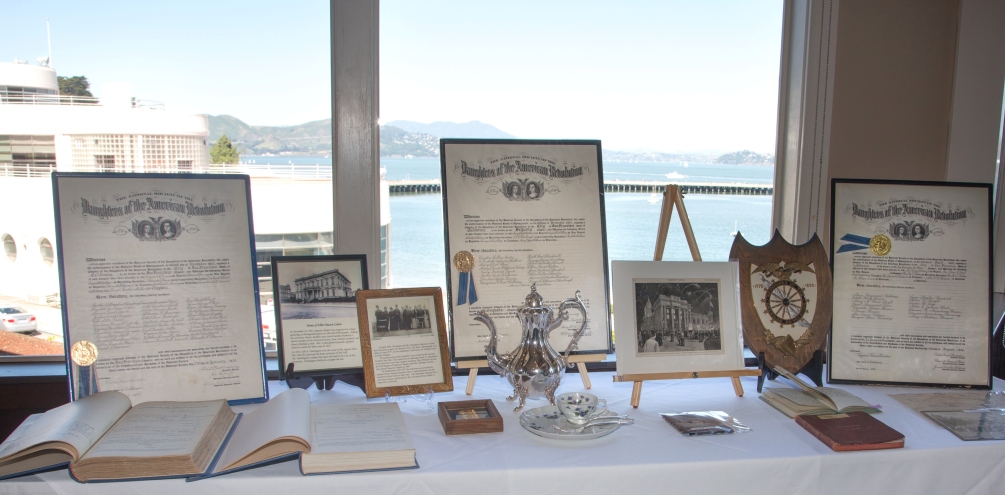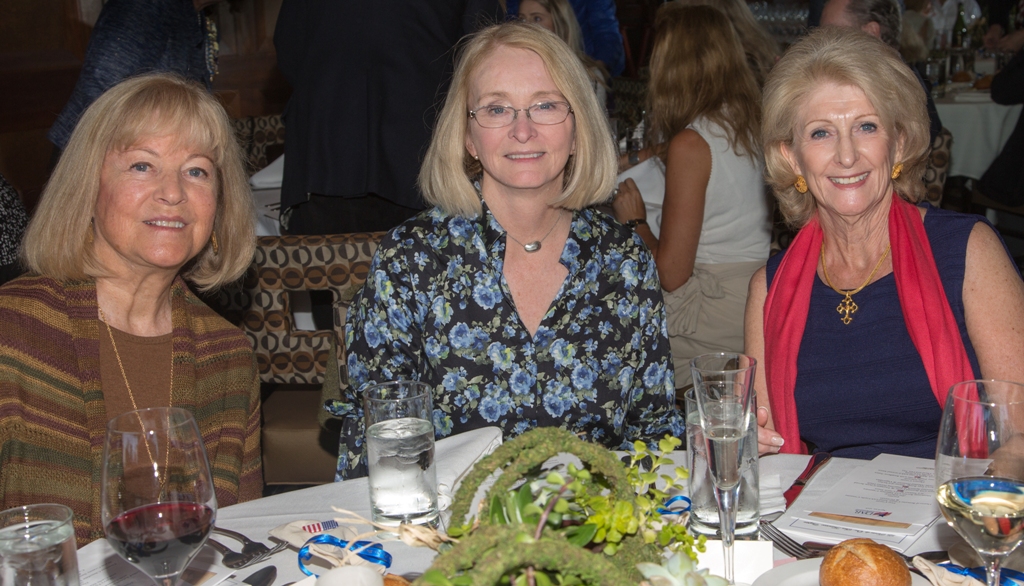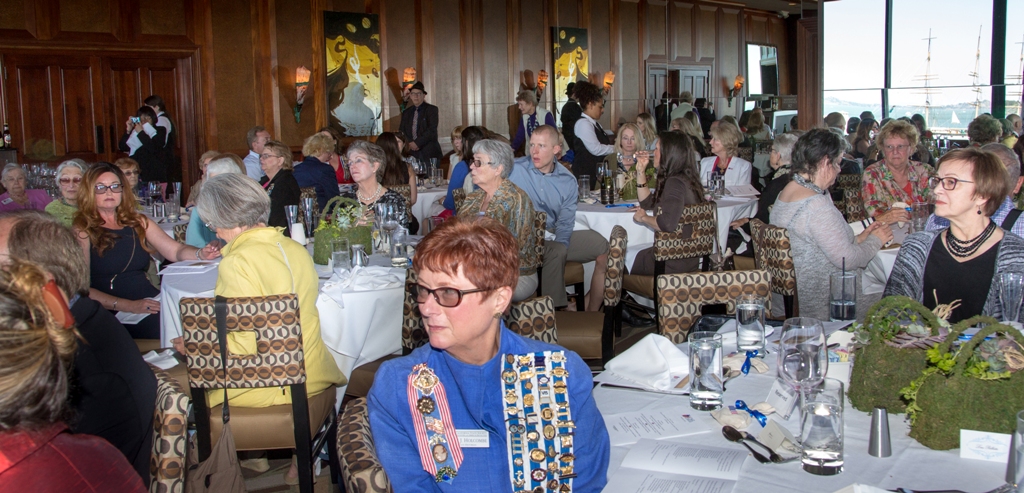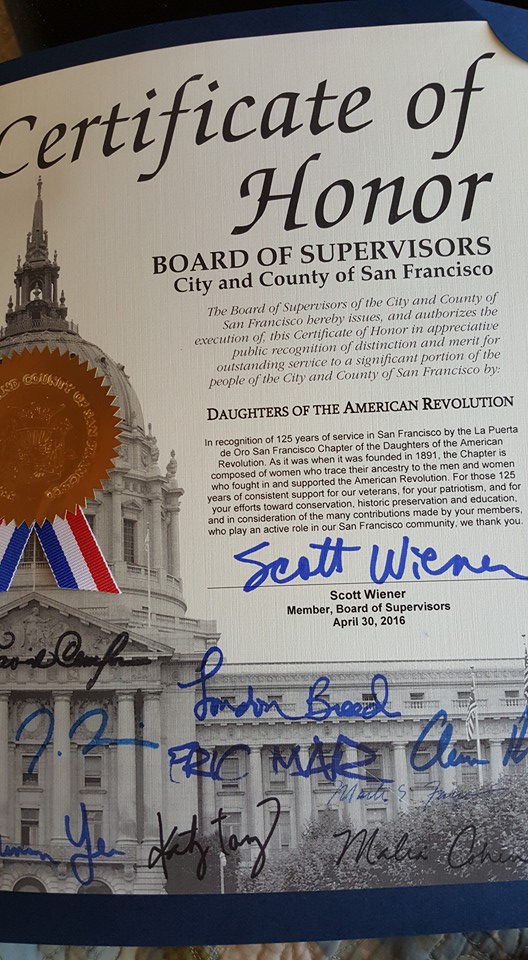News

Featured Article
Celebrating 125 Years of Service
April 2016

Our Founders would have been very proud of our chapter members in the recognition of our 125th anniversary at a celebratory luncheon. Not only was the anniversary of the organization of the Sequoia Chapter remembered, but also many of the accomplishments of all four chapters were reflected upon.
Chapter members were honored by the presence of three California State Officers: State Vice Regent and Regent-elect Beverly Moncrieff, Corresponding Secretary and State Vice Regent-elect Adele Lancaster, State Historian Sally Holcombe and State Corresponding Secretary-elect Christina Ramos.
The setting was fitting, with our banquet room overlooking the beautiful San Francisco Bay on a spectacular sunny day. Also sharing in our celebration were representatives from Presidio DAR Chapter and San Francisco SAR Chapter. Chapter Regent Carolyn Patrick gave a warm welcome to all, and State Regent-elect Bev Moncrieff added her congratulations on the many decades of service from our members. In his Proclamation, Mayor Ed Lee proclaimed April 30 as La Puerta de Oro–San Francisco Day. The Board of Supervisors also sent a Proclamation, affirming what our members have done for the community over the years.
Chapter member Lora Pallatto, in the persona of Sarah Isabelle Hubbard, provided a delightful glimpse back to the early years of the founding of Sequoia chapter, the oldest of our four chapters. Lora transported the guests back in time to our first meetings and described much of the detail of our chapter’s first meeting room. Many Revolutionary War artifacts in the room were donated by chapter members in those years, some having resided in their families for generations. Everyone in attendance showed much appreciation to the Color Guard, active duty Coast Guard from the Alameda Coast Guard Base.
Voices were raised in song, from the Star Spangled Banner to O Colombia, the Gem of the Ocean. Chapter members Meg Keenan and Lora Pallatto entertained the group with a lovely rendition of Revolutionary Tea.

Greetings from President General Lynn Forney Young were read, in which she commended us for our steadfastness in our efforts “to promote our noble objectives and to preserve our American heritage of freedom for future generations.”
Many chapter members brought family and friends to join in the celebration of our 125 years of service. Table decorations beautifully created by Jane Perry and Linda Mariani adding to the lovely setting. Members and guests showed great interest in the table of chapter memorabilia on display. Several items from our archives were on view, including three of our original charters, a La Puerta de Oro Minutes book from 1896, a photo of the Nob Hill home in which Sequoia Chapter was organized on Dec. 10, 1891, and much more. Two of our bound books of original applications were displayed, interesting for both the historic information to the excellent method of preservation.

Each guest received a souvenir booklet with highlights of each of our four chapters’ activities over the years and Tributes to many of our Patriots. Our celebration luncheon was enjoyed by all, giving us a renewed sense of purpose for the mission of our organization. Here’s to our next 125 years!
Catherine McCausland
Chapter Historian

![]()
2013–2014 Season Highlights
In 2013 our chapter was awarded a Special Projects grant from the National Society, allowing us to continue restoration of the Arch of Colonial Trees in Golden Gate Park. The final three replacement trees were planted, the boulder with the historic DAR plaque was moved to the entrance, and a brochure was developed to guide park visitors. We are pleased that this endeavor has contributed to conservation, historic preservation and education in our community.

Designed by Annette Litle. Download full Arch of Colonial Trees brochure and map here (pdf).
Our chapter’s response to the President General’s Celebrate America! initiative has been outstanding, with over 3,000 volunteer hours reported by chapter members in 2013. Our members’ activities included giving time in schools, hospitals, churches, museums, and the American Legion; environmental work; tutoring; driving for the elderly; working at a food bank; and many more.
Our support of veterans at the San Francisco VA Hospital continues with donations of both supplies and funds for much-needed bookshelves in the lending library for patients and their families.
Interest in ancestral research has led to popular informal genealogy gatherings and classes for chapter members. Meeting topics range from organizing one's research to breaking through "brick walls," and include both beginning and intermediate research classes.
The creativity of our members has been recognized through the American Heritage Committee, with our members’ crafts and needlework placing at the state and national levels.
Another contribution to historic preservation of our chapter is the current project to bind our many original DAR applications. These beautiful records on high-quality, linen-blend paper, some signed by early DAR leaders, are treasures of history, many dating back over 100 years. They include applications of San Francisco women who made a difference in their city in times of both prosperity and need. The handwritten stories of their patriots’ service are fascinating and moving. This project will assure these documents are preserved for the future.
Featured Article
DAR and ROTC, a Longstanding San Francisco Alliance
Spring 2014
The La Puerta de Oro–San Francisco DAR chapter has a longstanding tradition of presenting our city’s ROTC (Reserve Officers’ Training Corps) youth with medals at the end of each academic year, recognizing their outstanding achievements. The DAR Defense Committee has awarded ROTC medals since 1967, as the ROTC program plays a vital role in supplying trained officers to our armed forces. The presentation of these awards fulfills two of the important objectives of DAR: the support of education and the promotion of patriotism.
Our chapter awards medals to outstanding cadets in three different programs: the University of San Francisco ROTC, the San Francisco Unified School District JROTC (Junior ROTC), and the Sea Cadets, Arkansas Division, based on Yerba Buena Island.
Criteria for cadet selection include: demonstrated loyalty and patriotism, and academic achievement, both in the top 25 percent scholastically and in ROTC classes. Recipients must possess qualities of dependability, good character, adherence to military discipline, and leadership. Students receiving medals are selected by the commanders of their units.
The JROTC teaches high school students leadership skills, citizenship, respect for themselves and one another. Community service projects and student-taught classes train the cadets to motivate and direct others, and to give back to their communities. The curriculum uses contemporary models and methods to enhance learning that have proven to help students perform better in both their JROTC classes and in their general schoolwork. While JROTC is not a program designed to recruit students to the armed forces, its focus is to develop strong, civic-minded individuals ready to make a significant contribution to their country.
ROTC is a college/university-level program that trains cadets and commissions them as officers in the armed forces upon graduation. When President Wilson signed the National Defense Act of 1916, the ROTC was born. The program consists of a diverse group of men and women—the first class of female cadets were commissioned in 1976. ROTC is the largest commissioning source in the US military. Many scholarships are awarded to qualified students, some paying for the student’s entire college education. The curriculum is focused on giving cadets the tools and confidence to lead, to make decisions in complicated circumstances, and to excel in self-discipline.
The US Naval Sea Cadet Corps, which partners with the US Navy and the Coast Guard, is a youth development program that instills into its cadets the values of teamwork, discipline, camaraderie and service. Cadets, aged 13 through 17, begin with a mandatory two-week training session focusing on the Navy’s core values of honor, courage and commitment. One of the program’s goals is to develop interest and ability in seamanship and seagoing skills. Cadets can participate in advanced training aboard Navy and Coast Guard vessels, or even take classes wherein they learn to build underwater robots.
Each year in spring, a representative from our chapter attends the three awards ceremonies in San Francisco to present the highly coveted medals. When these decorated students apply for college or military stations, the fact that they can add the DAR Outstanding Cadet Award to their résumé is of great value and pride.
![]()
2012–2013 Season Highlights
In October our Juniors held a very successful and enjoyable event to send two military families to the Healing Adventures Family Camp, a project of the National Military Family Association. The evening cocktail event had a "Mad Men" theme, with attendees dressed in 1950s and '60s styles. Fun and generosity are always a wonderful combination.
Our December meeting was devoted to our annual Christmas stocking stuffing for military families. Members brought small gifts and candies, suitable for boys, girls, and parents to the meeting. Over 90 bright red stockings were filled with these treats, and delivered to the USO at San Francisco International Airport. They are given to military families who pass through the airport, brightening their holidays.
Our work for veterans at the VA Hospital in San Francisco continues throughout the year, with donations of books and magazines, and warm coats and socks in the winter. At other times smiles are our goal, with gift bags of Halloween treats, and Valentines in February.
![]()
Featured Article
Rededication of the Arch of Colonial Trees
Continuing the Work of our 1896 Daughters
Spring 2012
The sun couldn't have been brighter as our chapter members and guests gathered in the lovely Pioneer Meadow on March 31, 2012 to rededicate our Arch of Colonial Trees.
The program began with the Young American Patriots Fife & Drum Corps marching across the meadow, playing the colonial tune Yankee Doodle. After posting the colors, everyone recited the Pledge of Allegiance, led by our Veterans Administration Voluntary Service (VAVS) representative, Jane Perry. Second Vice Regent Annette Litle led the singing of the National Anthem, accompanied by the Fife & Drum Corps.
First Vice Regent Claudia Feurey introduced our distinguished guests, including State Vice Regent and Regent-Elect Debra Jamison, who read greetings from State Regent Karon Jarrard. Other state officers were welcomed, including Organizing Secretary and Registrar-Elect Bev Moncrief, Historian Leslie Pfiefer, Librarian Karen Theofanides, and Recording Secretary-Elect Midge Enke. District III Director Barbara Wilson also attended with two of her Santa Rosa Chapter members.
San Francisco Mayor Ed Lee issued a Certificate of Honor to our chapter for our work on this project; Juniors Chair Laura Manion read his message to the group.
Mr. Brent Dennis, assistant director of operations for Golden Gate Park, welcomed everyone and conveyed his thanks and well wishes on the project. Regent Catherine McCausland then gave a brief account of the history of the DAR trees in the park, starting with the original desire of Sequoia Chapter members to have some of the hallowed ground from important Revolutionary War sites right here in their city. From the Liberty Tree, in 1894, to our most recent planting in 2012, our Daughters have planned the trees and ceremonies to reflect the history and to honor the memory of those who gave so much for our independence.
Chaplain Kathy Sanford led the rededication itself with the traditional DAR ritual, used since the 1930s. To further celebrate, the guests were entertained with the colonial tunes "Chester" and "Brandywine" by the young Fifers & Drummers. The Corps' leader, Mr. Jason Giaimo, shared some of the interesting history of the fife and drum in the American military.
In closing, benediction was given by the Rev. David R. Forbes, who read the beautiful "George Washington's Prayer." Although written many years ago, the words are just as relevant today.
All then enjoyed the wonderful refreshments and visited with our guests and their families. Many strolled along the Arch, reading the beautiful signs that our conservation chair, Sally Tobin, had prepared, identifying the trees, their states of origin, and planting dates. Many of the original trees are still thriving, and our chapter has undertaken the long-term project of replacing those that have not survived. Our first two replacement trees were a magnolia for South Carolina and a hemlock for Pennsylvania. This commitment, with the wonderful work of the park gardeners, will ensure the grove is here for generations to come.
![]()
Liberty Tree Planted by Sequoia Chapter
(Original 1894 newspaper article) Publisher: H. S. Crocker; 1894. Photographer: I. W. Taber
On April 19, 1894, the 119th Anniversary of the Battle of Lexington, the chapter planted a Sequoia tree adjacent to the Conservatory of Flowers in Golden Gate Park, with music from the US First Infantry Band, benediction, honor guards from the US and France, commentary by State and Chapter Officers and other dignitaries, and finally a salvo of artillery from the Army’s Fifth Artillery, Battery D.
One of the most notable aspects of the planting was the introduction of earth from the graves of American Revolutionary heroes, battlefields and other historic locations. Some of the graves included: George Washington (original Mt. Vernon grave), Thomas Jefferson, John Hancock, Patrick Henry, the Marquis de Lafayette (from his Paris grave), Betsy Ross, Francis Scott Key, and many more. Soil came from battlefields including Lexington, Concord, Saratoga, and the trenches of Valley Forge.
Speakers included US Army General W.H. Barnes who recalled listening to Abraham Lincoln’s Inaugural Address on the Capital steps. Using a silver trowel, Sequoia Chapter Regent Mrs. William Alvord began the planting by placing the earth from Washington’s grave. The handle of the silver trowel was made of wood from a branch of a tree from Mt. Vernon, planted during Washington’s time. Also placed in the ground was a piece of the cannon used April 19, 1775, at Lexington.
